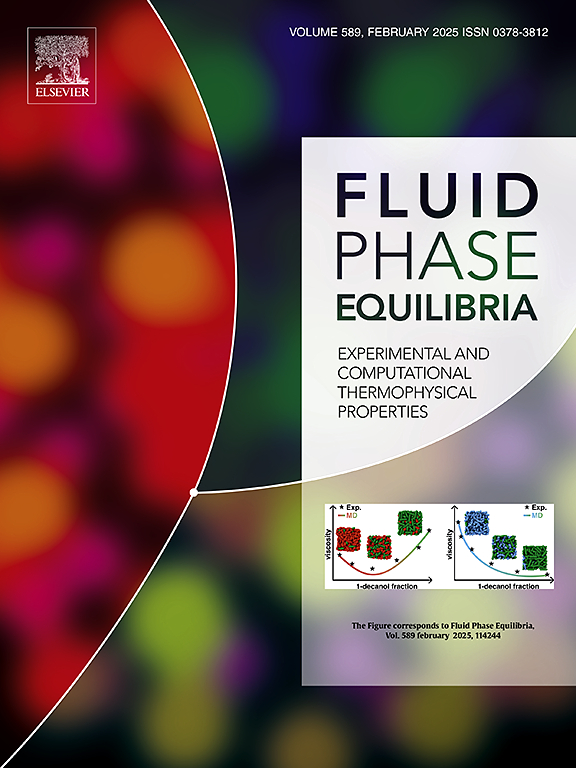Investigating the dissolution behavior and revealing the thermodynamic mechanism of Ethyl L-phenylalaninate hydrochloride in several neat and binary solvents
IF 2.7
3区 工程技术
Q3 CHEMISTRY, PHYSICAL
引用次数: 0
Abstract
This study investigated the solubility of ethyl l-phenylalaninate hydrochloride (H-Phe-OEt.HCl) in seven neat solvents (1-Propanol, 1,4-Dioxane, 2-Butoxyethanol, 2-Propoxyethanol, Isopropyl alcohol, 1-Butanol, THF) and two binary (2-Propoxyethanol + THF, 2-Butoxyethanol + 1-Propanol) solvent mixtures from 283.15 K to 323.15 K under atmospheric pressure. The solubility of H-Phe-OEt.HCl in the neat solvents was correlated by the NRTL, Buchowski-Ksiazczak λh, Margules, NRTL-SAC, Jouyban and van't Hoff model. For the binary solvent mixtures (2-Propoxyethanol + THF, 2-Butoxyethanol + 1-Propanol), the NRTL, van't Hoff, Jouyban-Acree van't Hoff and Ma model were employed to correlate the obtained solubility. Hansen solubility parameters (HSPs) was used to evaluate the dissolution trend of H-Phe-OEt.HCl in the selected solvents. In addition, the apparent thermodynamic parameters such as ΔsolH° (apparent standard enthalpy change), ΔsolS° (apparent standard entropy change) and ΔsolG° (apparent standard Gibbs energy change) was calculated to evaluate the dissolution mechanism, all the positive values of ΔsolH°, ΔsolS° and ΔsolG° illustrated that the dissolution of H-Phe-OEt.HCl was an endothermic and entropy-increase process. The current study could provide critical insights for optimizing industrial crystallization, purification, and separation processes of H-Phe-OEt.HCl.
研究了l -苯丙酸乙酯在几种纯溶剂和二元溶剂中的溶解行为并揭示了热力学机理
本研究考察了l-苯丙酸乙酯盐酸盐(h -ph - oet . hcl)在7种纯溶剂(1-丙醇、1,4-二氧环、2-丁氧基乙醇、2-丙氧基乙醇、异丙醇、1-丁醇、THF)和2种二元溶剂(2-丙氧基乙醇+ THF、2-丁氧基乙醇+ 1-丙醇)中283.15 K至323.15 K的常压下的溶解度。h - ph - oet的溶解度。通过NRTL模型、Buchowski-Ksiazczak λh模型、Margules模型、NRTL- sac模型、Jouyban模型和van't Hoff模型对纯溶剂中的HCl进行了相关性分析。对于二元溶剂混合物(2-丙氧基乙醇+ THF, 2-丁氧基乙醇+ 1-丙醇),采用NRTL、van't Hoff、Jouyban-Acree van't Hoff和Ma模型来关联得到的溶解度。采用汉森溶解度参数(HSPs)评价h - ph - oet的溶出趋势。选择溶剂中的HCl。此外,通过计算表观标准焓变ΔsolH°、表观标准熵变ΔsolS°和表观标准吉布斯能变ΔsolG°等热力学参数来评价溶解机理,ΔsolH°、ΔsolS°和ΔsolG°均为正值,说明h - ph - oet发生了溶解。HCl是一个吸热和熵增加的过程。本研究可为优化h - fe - oet . hcl的工业结晶、纯化和分离工艺提供重要见解。
本文章由计算机程序翻译,如有差异,请以英文原文为准。
求助全文
约1分钟内获得全文
求助全文
来源期刊

Fluid Phase Equilibria
工程技术-工程:化工
CiteScore
5.30
自引率
15.40%
发文量
223
审稿时长
53 days
期刊介绍:
Fluid Phase Equilibria publishes high-quality papers dealing with experimental, theoretical, and applied research related to equilibrium and transport properties of fluids, solids, and interfaces. Subjects of interest include physical/phase and chemical equilibria; equilibrium and nonequilibrium thermophysical properties; fundamental thermodynamic relations; and stability. The systems central to the journal include pure substances and mixtures of organic and inorganic materials, including polymers, biochemicals, and surfactants with sufficient characterization of composition and purity for the results to be reproduced. Alloys are of interest only when thermodynamic studies are included, purely material studies will not be considered. In all cases, authors are expected to provide physical or chemical interpretations of the results.
Experimental research can include measurements under all conditions of temperature, pressure, and composition, including critical and supercritical. Measurements are to be associated with systems and conditions of fundamental or applied interest, and may not be only a collection of routine data, such as physical property or solubility measurements at limited pressures and temperatures close to ambient, or surfactant studies focussed strictly on micellisation or micelle structure. Papers reporting common data must be accompanied by new physical insights and/or contemporary or new theory or techniques.
 求助内容:
求助内容: 应助结果提醒方式:
应助结果提醒方式:


